
Cardiff Arms Park, also known as The Arms Park, is situated in the centre of Cardiff, Wales. It is primarily a rugby union stadium, but it also has a bowling green. The Arms Park was host to the British Empire and Commonwealth Games in 1958, and hosted four games in the 1991 Rugby World Cup, including the third-place play-off. The Arms Park also hosted the inaugural Heineken Cup Final of 1995–96 and the following year in 1996–97.

Croke Park is a Gaelic games stadium in Dublin, Ireland. Named after Archbishop Thomas Croke, it is referred to as Croker by GAA fans and locals. It serves as both the principal national stadium of Ireland and headquarters of the Gaelic Athletic Association (GAA). Since 1891 the site has been used by the GAA to host Gaelic sports, including the annual All-Ireland in Gaelic football and hurling.
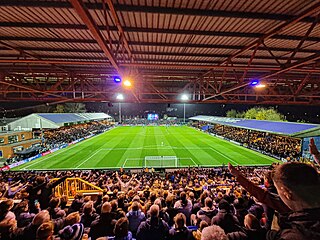
Edgeley Park is a football stadium in Edgeley, Stockport, England. Built for Stockport RFC, a rugby league club, in 1891, by 1903 the rugby club was defunct and Stockport County Football Club moved in. The ground is set to be increased to a capacity of around 18,000 with the start of the project in 2025.

Villa Park is a football stadium in Aston, Birmingham, with a seating capacity of 42,640. It has been the home of Premier League club Aston Villa since 1897. The ground is less than a mile from both Witton and Aston railway stations and has hosted sixteen England internationals at senior level, the first in 1899 and the most recent in 2005. Villa Park has hosted 55 FA Cup semi-finals, more than any other stadium, and it is the 10th largest in England.
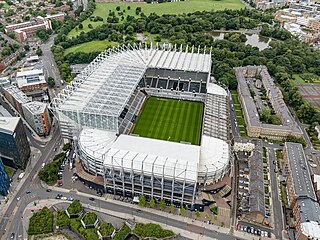
St James' Park is a football stadium in Newcastle upon Tyne, England. It is the home of Newcastle United. With a seating capacity of 52,350 seats, it is the 8th largest football stadium in England.
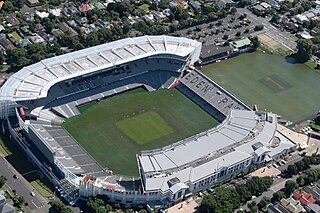
Eden Park is a sports venue in Auckland, New Zealand. It is located three kilometres southwest of the Auckland CBD, on the boundary between the suburbs of Mount Eden and Kingsland. The main stadium has a nominal capacity of 50,000, and is sometimes referred to as New Zealand's national stadium. The stadium is used primarily for rugby union in winter and cricket in summer, and has also hosted rugby league and association football matches, as well as concerts and cultural events. It is owned and operated by the Eden Park Trust Board, whose headquarters are located in the stadium.
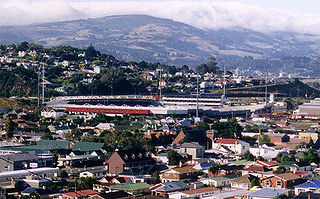
Carisbrook was a major sporting venue in Dunedin, New Zealand. The city's main domestic and international rugby union venue, it was also used for other sports such as cricket, football, rugby league and motocross. In 1922, Carisbrook hosted the very first international football match between Australia and New Zealand. The hosts won 3-1.

Lancaster Park, also known as Jade Stadium and AMI Stadium for sponsorship reasons, was a sports stadium in Waltham, a suburb of Christchurch in New Zealand. The stadium was closed permanently due to damage sustained in the February 2011 earthquake and demolished in 2019. It has since been transformed into a public park with facilities for community sport, and was re-opened in June 2022.

North Sydney Oval is a multi-use sporting facility in North Sydney, New South Wales, Australia, owned and operated by North Sydney Council. First used as a cricket ground in 1867, it is also used for Australian rules football, rugby league, rugby union and soccer.

Yarrow Stadium is situated in the central suburb of Westown in New Plymouth, Taranaki, New Zealand, with main vehicle access off Maratahu Street. Named the third best rugby stadium on earth by New Zealand Rugby World magazine in May 2009, Yarrow Stadium conforms with the International Rugby Board's "clean stadium" policy.

Perth Rectangular Stadium is a sports stadium in Perth, the capital of the Australian state of Western Australia. Located close to Perth's central business district, the stadium currently has a maximum capacity of 20,500 people for sporting events and 25,000 people for concerts, with the ground's record attendance of 32,000 people set during an Ed Sheeran concert in 2015. The land on which the stadium was built, known as Loton Park, was made a public reserve in 1904, with the main ground developed several years later.
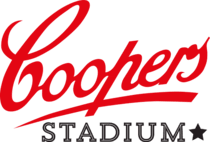
Hindmarsh Stadium is a multi-purpose stadium in Hindmarsh, an inner western suburb of Adelaide, South Australia. It is the home of the Australian A-League team, Adelaide United.

The Willows Sports Complex was a grass football stadium situated in Townsville, Queensland, Australia. It was used predominantly as a rugby league ground as the home ground of the North Queensland Cowboys National Rugby League club. The ground was also used for rugby union and soccer. From 2009 to 2011, A-League football club North Queensland Fury called it home.

The Halton Stadium is a multi-purpose rugby league, football and American football stadium in Widnes, Cheshire, England. It is the home of Rugby League side Widnes Vikings of the Betfred Championship, football team Widnes Football Club of the Northern Premier League who play their home games at the stadium, and also the American football side Halton Spartans of the BAFA National Leagues, the Halton Spartans having competed in the BAFANL national American football league since 2015. The stadium is all seater and has a total capacity of 13,350.

FMG Stadium Waikato is a major sporting and cultural events venue in Hamilton, New Zealand, with a total capacity of 25,800. Four areas contribute to this capacity: The Brian Perry Stand holding 12,000, the WEL Networks Stand holding 8,000, the Goal Line Terrace holding 800 and the Greenzone can hold up to 5,000 people. The capacity can be extended, however, by temporarily adding 5,000 seats to the Goal Line Terrace area. The stadium, owned by the Hamilton City Council, regularly hosts two rugby union teams:

Cougar Park is a rugby league stadium in Keighley, England, which is the home stadium of the Keighley Cougars. Its capacity is 7,800 people. It also hosted a match during the 1995 Rugby League World Cup. From 1899 until 1995, it was known as "Lawkholme Lane". Football has also played at the ground, Silsden F.C. had played their home matches at the venue between 2003 and 2010. and Steeton A.F.C. played at the ground in 2018 and 2019.
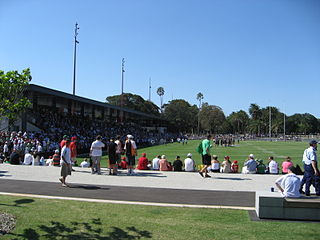
Redfern Oval is an Australian football ground, in the Sydney suburb of Redfern, New South Wales, Australia. The South Sydney Rabbitohs Rugby League Football Club played at Redfern Oval between 1948 and 1987. Rabbitoh supporters often refer to Redfern Oval as "The Holy Land".

The Melbourne Rectangular Stadium, referred to as AAMI Park due to a sponsorship arrangement, is an outdoor sports stadium situated on the grounds of Edwin Flack Field within the Sports and Entertainment Precinct in the heart of the Melbourne central business district.
Turnbull Thomson Park is a public park located in Invercargill, Southland, South Island, New Zealand. It is within the region of Southland Plains, covered with grass on low flatland with some trees around the large open space. The park is mainly used for sports and recreation purposes. As a natural reserve, it also has unique environmental and scenic value to the city.
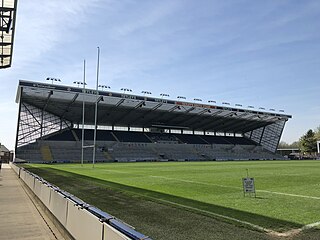
Headingley Rugby Stadium is a Rugby League stadium in Headingley, Leeds and shares the same site as Headingley Cricket Ground. It is the home ground of the Leeds Rhinos. Headingley is the 5th largest rugby league stadium in England.




















